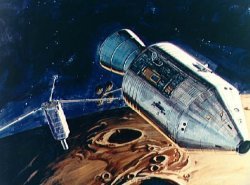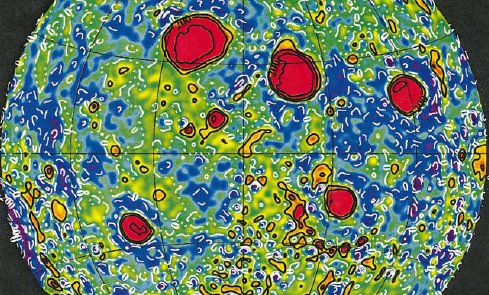
Nov.
6, 2006:
SOURCE:
NASA News Release
Near the end of the mission of Apollo 16, on April 24, 1972, just before returning back home to Earth, the three astronauts released one last scientific experiment: a small "subsatellite" called PFS-2 to orbit the Moon about every 2 hours.
The intention? Joining an earlier subsatellite PFS-1, released by Apollo 15 astronauts eight months earlier, PFS-2 was to measure charged particles and magnetic fields all around the Moon as the Moon orbited Earth. The low orbits of both subsatellites were to be similar ellipses, ranging from 55 to 76 miles (89 to 122 km) above the lunar surface.
Instead, something bizarre happened.
What happened? The Moon itself plunged the subsatellite to its death. That's the conclusion of Alex S. Konopliv, planetary scientist at NASA's Jet Propulsion Laboratory in Pasadena. He and several colleagues have been analyzing the orbits of various Moon-orbiting satellites since PFS-2, notably the 1998–99 mission of Lunar Prospector.
"If the Moon were a uniform sphere, you could have an orbit that was perfect ellipse or circle," Konopliv explained. "The Moon has no atmosphere to cause drag or heating on a spacecraft, so you can go really low: Lunar Prospector spent six months orbiting only 20 miles (30 km) above the surface."
So why did PFS-2, which was inserted into an elliptical orbit that originally carried it from 52 miles (97 km) to 66 miles (120 km), end up as a kamikaze blast of broken aluminum struts and solar panels?
The Moon is extraordinarily lumpy, gravitationally speaking," Konopliv continues. "I don't mean mountains or physical topography. I mean in mass. What appear to be flat seas of lunar lava have huge positive gravitational anomalies—that is, their mass and thus their gravitational fields are significantly stronger than the rest of the lunar crust." Known as mass concentrations or "mascons," there are five big ones on the front side of the Moon facing Earth, all in lunar maria (Latin for "seas") and visible in binoculars from Earth.
"The
mascons' gravitational anomaly is so great—half a percent—that it actually
would be measurable to astronauts on the lunar surface. "If you were standing
at the edge of one of the maria, a plumb bob would hang about a third of
a degree off vertical, pointing toward the mascon," Konopliv says. Moreover,
an astronaut in full spacesuit and life-support gear whose lunar weight
was exactly 50 pounds at the edge of the mascon would weigh 50 pounds and
4 ounces when standing in the mascon's center.

So what does this mean for eventual lunar exploration?
e careful of the orbit chosen for a low-orbiting lunar satellite. "What counts is an orbit's inclination," that is, the tilt of its plane to the Moon's equatorial plane. "There are actually a number of 'frozen orbits' where a spacecraft can stay in a low lunar orbit indefinitely. They occur at four inclinations: 27º, 50º, 76º, and 86º"—the last one being nearly over the lunar poles. The orbit of the relatively long-lived Apollo 15 subsatellite PFS-1 had an inclination of 28º, which turned out to be close to the inclination of one of the frozen orbits—but poor PFS-2 was cursed with an inclination of only 11º.
Alternatively, if there are mission reasons for choosing a non-frozen orbital inclination, plan to do frequent course corrections. Lunar Prospector had to do a maneuver every two months to keep itself in its initial circular orbit of 60 miles (100 km)—and more often than once a month when it was orbiting at only 20 miles (30 km) altitude. When its fuel tank was nearly empty, the scientists knew its end was near, so they deliberately crashed it on July 30, 1999, near the Moon's south pole to observe its plume of lunar dust. After a year and a half, the Moon had claimed the spacecraft for its own.
Bottom line, says Konopliv: "Carry plenty of fuel."
Author:
Trudy
E. Bell | Editor: Dr. Tony
Phillips | Credit: Science@NASA
MORE TO THE STORY
Lunar mascons are a mystery.
Although scientists generally agree they resulted from ancient impacts billions of years ago, it’s unclear how much of the excess mass is due to denser lava material filling the crater or how much is due to upwelling of denser iron-rich mantle material to the crust. Regardless of composition or origin, the mascons make the Moon the most gravitationally "lumpy" body known in the solar system. Although mascons also exist on Mars, none have been found on Venus or Earth; those two larger planets, however, have had an active tectonic (geological) past that has drawn their crusts down into their interiors several times in the past few billion years, homogenizing the distribution of mass.
Details about the subsatellites of both Apollos 15 and 16, including their orbital parameters, appear on p. 5-5 of Apollo 16 Mission Report.
A paper detailing the weird behavior of mascons on low lunar orbits (of about 100 km altitude) by Alex Konopliv and four coauthors is "Recent Gravity Models as a Result of the Lunar Prospector Mission" published in Icrarus, vol. 150, pp. 1-18, 2001 (available online only by subscription).
More about the mascons in the context of the gravitational lumpiness of the moon is "Improved Gravity Field of the Moon from Lunar Prospector," by Konopliv and colleagues.
An account of the deliberate crashing of Lunar Prospector into the Moon may be found here.